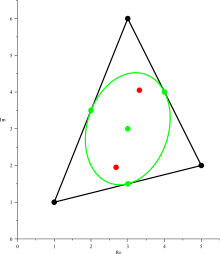Marden's theorem

In mathematics, Marden's theorem, named after Morris Marden but proven much earlier by Jörg Siebeck, gives a geometric relationship between the zeroes of a third-degree polynomial with complex coefficients and the zeroes of its derivative.
Statement of the theorem
A cubic polynomial has three zeroes in the complex number plane, which in general form a triangle, and the Gauss–Lucas theorem states that the roots of its derivative lie within this triangle. Marden's theorem states their location within this triangle more precisely:
- Suppose the zeroes z1, z2, and z3 of a third-degree polynomial p(z) are non-collinear. There is a unique ellipse inscribed in the triangle with vertices z1, z2, z3 and tangent to the sides at their midpoints: the Steiner inellipse. The foci of that ellipse are the zeroes of the derivative p'(z).
Additional relations between root locations and the Steiner inellipse
By the Gauss–Lucas theorem, the root of the double derivative p"(z) must be the average of the two foci, which is the center point of the ellipse and the centroid of the triangle. In the special case that the triangle is equilateral (as happens, for instance, for the polynomial p(z) = z3 − 1) the inscribed ellipse degenerates to a circle, and the derivative of p has a double root at the center of the circle. Conversely, if the derivative has a double root, then the triangle must be equilateral (Kalman 2008a).
Generalizations
A more general version of the theorem, due to Linfield (1920), applies to polynomials p(z) = (z − a)i (z − b)j (z − c)k whose degree i + j + k may be higher than three, but that have only three roots a, b, and c. For such polynomials, the roots of the derivative may be found at the multiple roots of the given polynomial (the roots whose exponent is greater than one) and at the foci of an ellipse whose points of tangency to the triangle divide its sides in the ratios i : j, j : k, and k : i.
Another generalization (Parish (2006)) is to n-gons: some n-gons have an interior ellipse that is tangent to each side at the side's midpoint. Marden's theorem still applies: the foci of this midpoint-tangent inellipse are zeroes of the derivative of the polynomial whose zeroes are the vertices of the n-gon.
History
Jörg Siebeck discovered this theorem 81 years before Marden wrote about it. However, Dan Kalman titled his American Mathematical Monthly paper "Marden's theorem" because, as he writes, "I call this Marden’s Theorem because I first read it in M. Marden’s wonderful book".
Marden (1945, 1966) attributes what is now known as Marden's theorem to Siebeck (1864) and cites nine papers that included a version of the theorem. Dan Kalman won the 2009 Lester R. Ford Award of the Mathematical Association of America for his 2008 paper in the American Mathematical Monthly describing the theorem.
A short and elementary proof of Marden’s theorem is explained in the solution of an exercise in Fritz Carlson’s book “Geometri” (in Swedish, 1943).[1]
See also
- Bôcher's theorem for rational functions
References
- Kalman, Dan (2008a), "An Elementary Proof of Marden's Theorem", The American Mathematical Monthly, 115: 330–338, ISSN 0002-9890
- Kalman, Dan (2008b), "The Most Marvelous Theorem in Mathematics", Journal of Online Mathematics and its Applications External link in
|journal=(help) - Linfield, B. Z. (1920), "On the relation of the roots and poles of a rational function to the roots of its derivative", Bulletin of the American Mathematical Society, 27: 17–21, doi:10.1090/S0002-9904-1920-03350-1.
- Marden, Morris (1945), "A note on the zeroes of the sections of a partial fraction", Bulletin of the American Mathematical Society, 51 (12): 935–940, doi:10.1090/S0002-9904-1945-08470-5
- Marden, Morris (1966), Geometry of Polynomials, Mathematical Surveys, 3, Providence, R.I.: American Mathematical Society
- Parish, James L. (2006), "On the derivative of a vertex polynomial" (PDF), Forum Geometricorum, 6: 285–288: Proposition 5
- Siebeck, Jörg (1864), "Über eine neue analytische Behandlungweise der Brennpunkte", Journal für die reine und angewandte Mathematik, 64: 175–182, ISSN 0075-4102